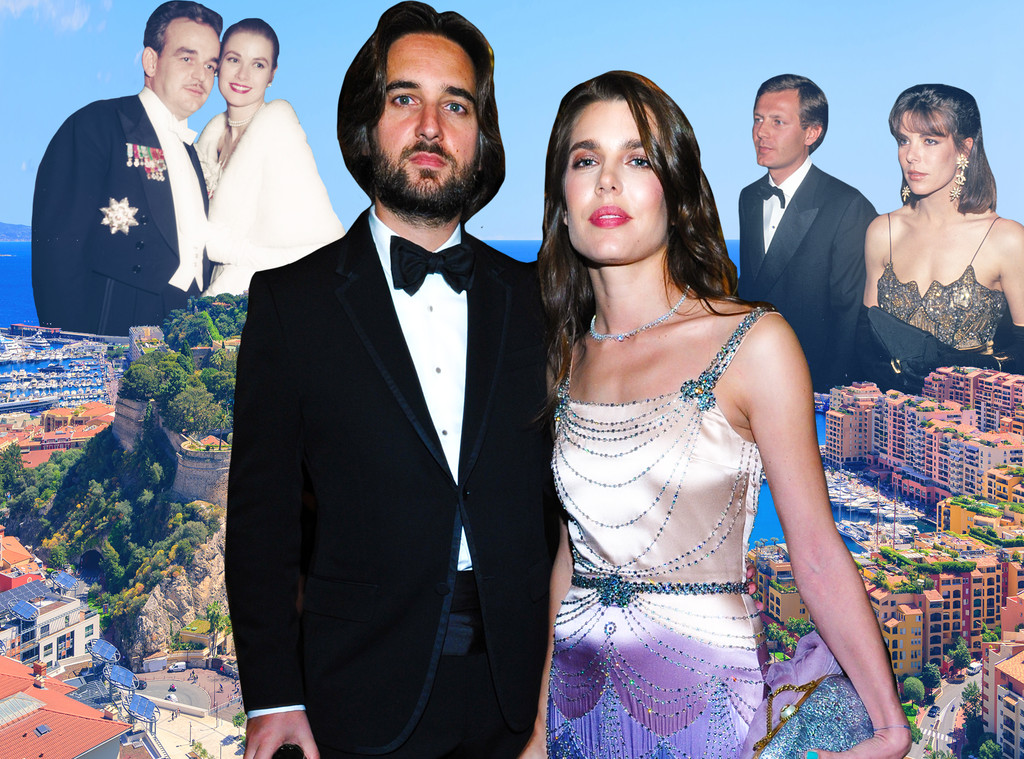
Getty Images; Melissa Herwitt/E! Illustration
To be a young royal is to be the subject of an endless slew of stories about either how fabulous you are or who you’re not getting along with.
Meghan Markle is still undergoing trial by fire, the rhapsodic talk of her pregnancy and continuing positive effect on the monarchy’s stodgy image intermingling with tales of her estranged family members’ latest opinions and dirt on her relationship with Kate Middleton.
Kate knows, too, that one day you’re perfection personified as a future queen and the next you’ve pissed off PETA.
And this doesn’t happen to only the British royal family.
Charlotte Casiraghi, the ultra-glamorous daughter of Princess Caroline and granddaughter of the late Princess Grace of Monaco, has been in the publishing business herself and knows just how the rumor cycle works.
“Mademoiselle Charlotte Casiraghi and Monsieur Dimitri Rassam, harassed by the scandal press, formally deny all unfounded rumors of their separation which are being circulated,” read a statement released by a publicist for the couple this week in response to a report making the rounds in Britain, France and Spain that they had split up, less than three months after welcoming a son together.
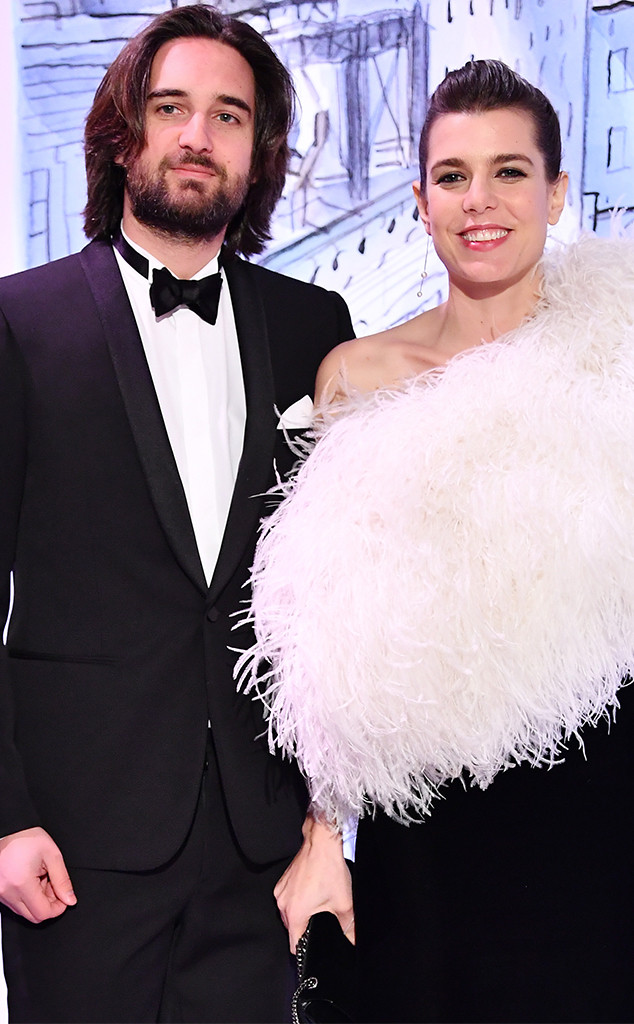
Pascal Le Segretain/Getty Images
“The explanation of this cynical and false information is simple: to portray conflict where there is not and never was, with the goal of monetizing it, because the announcement of a separation always motivates good sales,” the rep continued, per People. “Given the harmful nature of this rumor for themselves, their children and loved ones, they have agreed to ask their lawyer to initiate all legal proceedings, where possible before criminal courts.”
Reminiscent of Princess Anne‘s daughter, Zara Tindall, Casiraghi is a member of Monaco’s royal family and currently 11th in line to the throne, but does not sport a title and has proceeded to live her life not at all out of the spotlight (she made Vanity Fair‘s International Best Dressed List at 21), but not exactly under the sort of microscope that follows those a bit closer to the crown. (Incidentally, she and Tindall are both accomplished equestriennes, too.)
At the same time, Casiraghi’s family has commanded hearts and minds for a century as well, so mass interest in their lives has simply been passed down from generation to generation.
Perhaps fascination with the Monaco royals would have remained more of a continental pastime, but that all changed in 1956 when Prince Rainier III married American actress Grace Kelly, who gave up her lofty perch in Hollywood for love.
A piercing spotlight has been pointed at this storied playground for the rich and famous nestled on the French Riviera ever since.

REX/Shutterstock
Sixty-two years before Meghan Markle confirmed that she was putting her acting career behind her to marry Prince Harry, Kelly jolted the world with her announcement that after five prolific years as one of the biggest movie stars in the world, and a year after winning a Best Actress Oscar, she was switching jobs.
She had met Rainier in 1955 when she was in the South of France for the Cannes Film Festival and Olivia de Havilland more or less set them up with the help of her second husband, Paris Match editor Pierre Galante.
“I’m tempted to think it was destiny,” de Havilland told People in 2017. The Gone With the Wind star actually didn’t know Kelly personally, but they were all on the same train together and “it was an idea that struck [Pierre] for the first time while dining on the train after he learned Grace Kelly was a fellow passenger.” Galante and his editor-in-chief, Gaston Bonheur, were mainly thinking that getting those two together would make for a magnificent photo opportunity.
“Grace struck me on first encounter as a rather reserved, self-possessed, well brought up young woman,” de Havilland continued. They talked “on the small platform between the dining car and the next carriage when I overtook her to ask if she would agree to a meeting with Prince Rainier.”
At least Meghan didn’t need permission to meet Prince Harry on a blind date. Kelly, however, while perfectly happy to meet the prince, told de Havilland she had to check with MGM first, as she was under contract with the studio and close watch was kept on anything she did in the public sphere. (The loyalty didn’t always run both ways, as Kelly had once been suspended from MGM for refusing to make a movie with a script she thought was sub-par; she gave her Oscar-winning performance in The Country Girl while on loan to Paramount.)
A comedy of errors ensued, from a power outage at her hotel that prevented her from blowdrying or otherwise heat-styling her freshly washed hair to, creepily enough, a minor traffic accident when a car full of photographers hit the car she was riding in, to Prince Rainier not even being there when she arrived for their 3 p.m. meeting. She proceeded to tour the palace and, when he showed up and offered her a tour, told him she had already had the tour, thank you.
So Rainier—the only son of Prince Pierre of Monaco, Duke of Valentinois, and Monegasque Hereditary Princess, Charlotte, Duchess of Valentinois, and the first direct heir to the throne since 1758—asked if she’d like to see his private zoo. Photographers trailed dutifully behind them as they walked the grounds of the palace, which dates back to the 12th century and was captured by the Grimaldis in 1297. (The Monaco royals are the House of Grimaldi.)
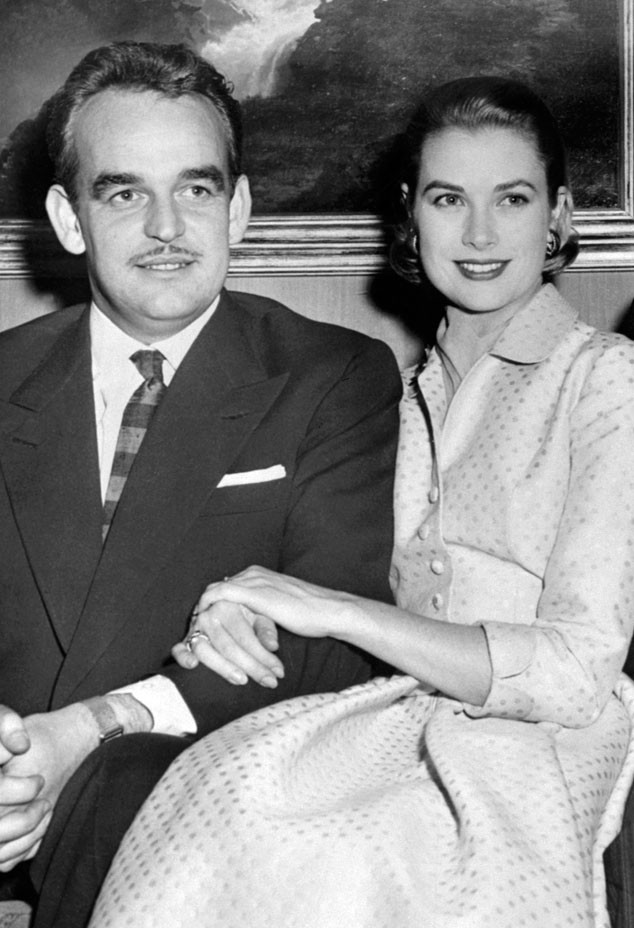
AFP/Getty Images
After that, Grace was driven back to Cannes, and that evening, when she saw Rainier again at a cocktail reception, “instead of offering her hand for a handshake, Grace extended her hand as if offering it to be kissed,” de Havilland recalled. “She was in a state of enchantment.”
Kelly went back to America and, after months of exchanging letter, Rainier went to visit her family’s home in Philadelphia that Christmas. Their engagement was announced on Jan. 5, 1956.
The betrothed couple gave an engagement interview and Rainier was the one to answer the question of whether Kelly was done acting. The answer was yes.
Incidentally, still being signed with MGM, she agreed to the studio getting exclusive filming rights to her wedding to get out of her contract.
Kelly set sail for Monaco on April 4, 1956, with 60 pieces of luggage; her poodle, Oliver; and her ivory silk and taffeta wedding gown by MGM costume designer Helen Rose, who had worked with Kelly on several pictures and went on to dress Elizabeth Taylor in Cat on a Hot Tin Roof and Butterfield 8.

Gilbert TOURTE/Gamma-Rapho via Getty Images
The wedding of Grace Kelly and Prince Rainier III after their whirlwind-by-any-standard courtship was not just the royal wedding of its day, coming nine years after the future Queen Elizabeth II married Prince Philip, but was deemed the “wedding of the century.”
They had a civil ceremony at the palace on April 18, 1956: “Miss Kelly, wearing a beige, lace dress with a close-fitting hat, was noticeably nervous throughout the proceedings,” the BBC reported. The newlyweds went to the front balcony and waved to the roughtly 500 people who were gathered outside.
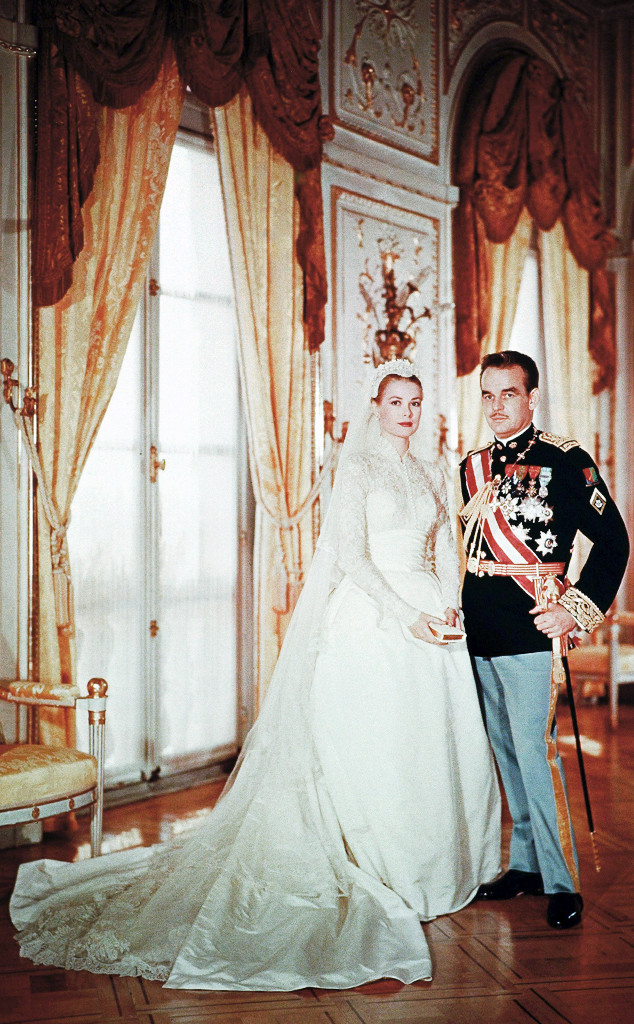
3777/Gamma-Rapho via Getty Images
That was followed the next day by their formal religious ceremony at the Cathedral of Monaco (the Mass was held in French) and lavish lunchtime reception attended by the Clooney of their day, Cary Grant, as well as Ava Gardner and Gloria Swanson. (De Havilland did apparently get an invitation, but was pregnant and unable to go.)
And with that, the former Grace Kelly of Philadelphia and Hollywood became Her Serene Highness Princess Grace of Monaco.
At least 1,500 reporters covered the wedding and Kelly later remarked that they all should have received battle ribbons for their efforts. Rainier recalled, “We both agreed that we should really have got married in a little chapel in the mountains.”
“There was so much pressure I didn’t remember it all,” he reflected to UPI in March 1981. “It was really hectic. I had to go and see a film of the wedding later on to realize what really happened.” (Thanks to MGM, he had one with all the Hollywood bells and whistles.)
They honeymooned aboard Rainier’s yacht, the Deo Juvante II, cruising around the Mediterranean.
No time was wasted in welcoming their first child, Princess Caroline, on Jan. 23, 1957. Prince Albert II was born on March 14, 1958 (due to Monaco’s patriarchal structure, he’s now the reigning monarch) and Princess Stéphanie rounded out the family on Feb. 1965.
“It’s hard to remember not being pregnant in those days,” Kelly later remarked, per James Spada’s Grace Kelly: The Secret Lives of a Princess.
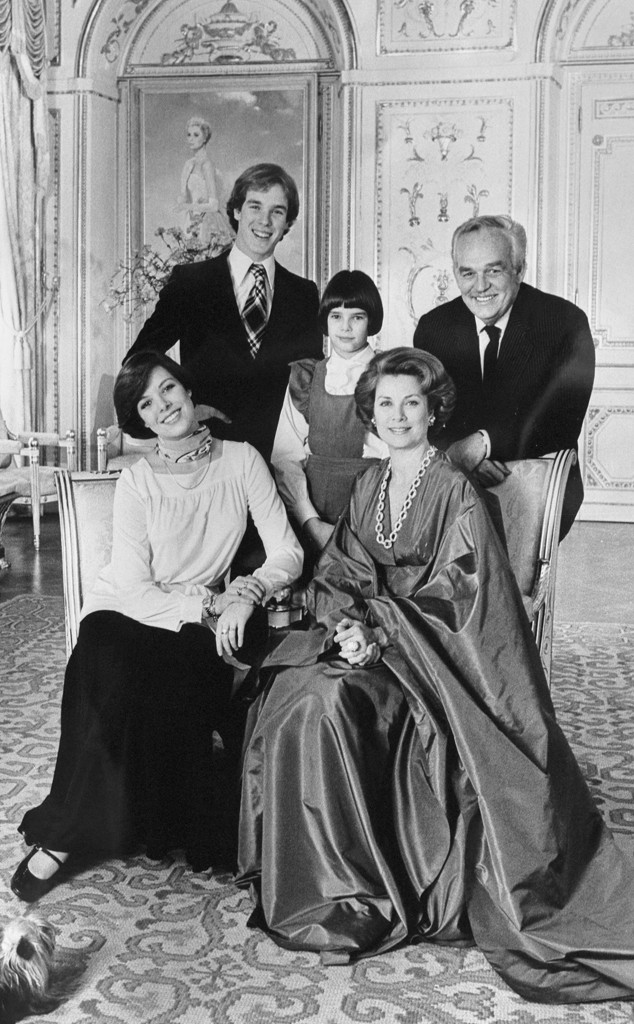
Bettmann
She considered herself a hands-on mother, who of course employed nannies but decided ahead of time to make sure they were around her own age, not wanting to be bossed around by anyone older and potentially overbearing. Grace’s father-in-law, Prince Pierre, has told her that Rainier’s nanny was so domineering, he was never allowed into the nursery to see him and his sister, Antoinette.
A story has been told about Grace, when she couldn’t get little Caroline to stop biting people, biting her own daughter’s arm to illustrate what she was doing. It worked.
“I’m afraid I’m very severe at times,” she once said, per Spada. “Outsiders might think I’m too hard on the children. But I give them just as much love as I do discipline, and it seems to work out very well.”
Kelly was actually considered not very strict at all, and instead would instantly excuse herself from a group if she heard one of her kids needed her, and her son and daughters were frequently seen running about the palace.
Caroline, however, told Isabelle Rivère and Peter Mikelbank for their 2017 book Albert II of Monaco, the Man and the Prince, that they felt closer to their nanny, Maureen Wood, than to their mother when they were little. “When [Wood] was leaving Roc Agel [the family’s farm in the hills above Monaco, to go on vacation], Albert and I would yell ‘Don’t go, don’t go!’ We were sad for days. Most often than not, our mother would end up calling her to ask her to come home earlier than planned.”
As it turned out, though, being an endlessly captivating full-time royal was not as entirely fulfilling as Grace might have envisioned it being at 26.
In 1961, Alfred Hitchcock, who had made three films with Kelly, got word that she was interested in starring in Marnie, a psychological thriller about a kleptomaniac with a traumatic past.
On March 19, 1962, the palace stated that yes, Princess Grace would be making this picture with Hitchcock, but surely that would be her last film. Her salary was reported as everything from $1 million to a percentage of the box office to a badly needed infusion of cash for the royal family.
“How can she be accused of this when her own family fortune is supposed to be so large?” Hitchcock said in an interview. “I think the trouble is that too many people, including the English, love stories about failures.”
Kelly eventually announced that she would donate whatever she made to charity, stating, per the Times of London, “In the same way as some priests or nuns perform common artistic, musical, or sporting tasks, for example, with the aim of raising funds for their work, I feel I am able to return to the cinema for a film with the charitable aim of aiding needy children and young sportsmen.”
But it wasn’t to be. Production was delayed a year so Hitch could finish The Birds and the plan ultimately unraveled. When Kelly was asked if she would want to be in another film down the road, she told Nice Matin, “I don’t like to say definitely, but it’s obvious that the same problems as Marnie would arise.” (The sticking point turned out to be a tax snafu, and her loyalty lay with the crown.)
Long before the release of the critically panned (and ultimately straight-to-Lifetime) film Grace of Monaco, starring Nicole Kidman, Kelly’s children dismissed the movie—which showed Kelly having deep misgivings about quitting acting for good—outright and said they wanted nothing to do with it.
“It recounts one rewritten and needlessly glamorized page in the history of Monaco and its family with both major historical inaccuracies and a series of purely fictional scenes,” Caroline, Albert and Stéphanie said in a statement in 2013. Two weeks before its premiere at Cannes in May 2014, they reiterated that the movie was based on “erroneous and dubious historical references” and the trailer was a “farce.”
“Coming to live here and having to behave in a certain way must have been hard for her at first,” Prince Albert, a fervent protector of his mother’s legacy, told People in 2014. “But I never heard her complain.”
But controversial treatment of a complicated subject aside, being royalty means that, no matter which country your palace sits in, members of the family can’t be seen as endorsing anything other than altruism, philanthropy and patriotism, and patronage is one of their few ways of showing which sort of causes are close to their hearts. (Hence, among other things, Queen Elizabeth II appointing Meghan her successor as patron of the National Theatre in London.)
So when Kelly offered to write a foreword for a Hitchcock biography in the 1970s, it was a big deal.
“I am constantly asked to endorse products and to comment on books, or say something about a movie,” she told High Society: The Life of Grace Kelly author Donald Spoto in 1975. “I cannot do that for many reasons. However, in your case I would make an exception.”
Kelly proceeded to write perhaps the least critical six paragraphs ever published about the infamously exacting and reputedly manipulative, misogynistic director.
“I…came to know him as a warm and understanding human being,” she wrote. “Mr. Hitchcock often is reputed to hold actors in disdain. But he actually has a special way with them, and is able to get exactly what he wants in the way of a performance…Of course, sometimes he merely wears them down until he gets what he wants.”
After Marnie fell through and Tippi Hedren went on to star in the film with Sean Connery, Kelly returned to the stage for dramatic readings, narrated some TV specials and documentaries, and made appearances on the small screen as herself. She also pre-taped a segment for the 40th Annual Academy Awards, in 1968. In 1977 an NBC News team came to shoot a special at the palace, but it was extremely scripted-sounding.
“When the camera wasn’t rolling, she kind of emptied her heart,” Lee Grant, who conducted the interview, told The Hollywood Reporter in 2015. “The truth was, her life was terribly restrained—she was princess of a little closed-off castle.”
Princess Grace had gone from Hollywood, where she had a carefully constructed public image but could technically do and say what she pleased, to again having another tightly controlled image but also within the confines of the equivalent of a gilded tower.
“The idea of my life as a fairy tale is itself a fairy tale,” Kelly told Donald Spoto.
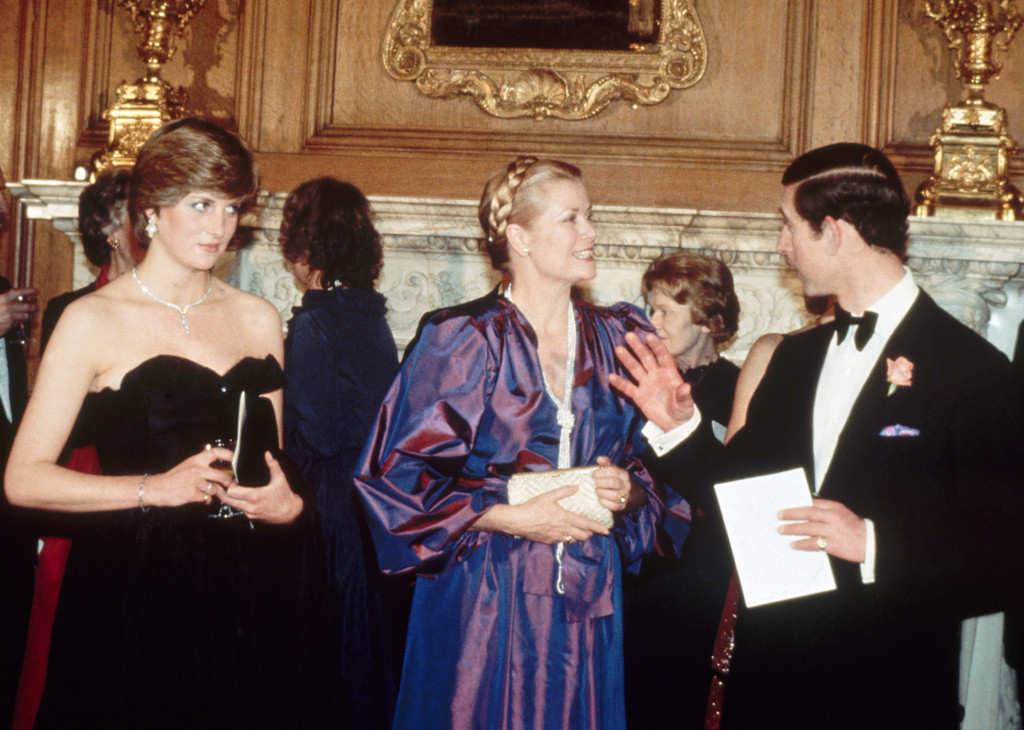
Pascal Le Segretain/Getty Images
And while she and Princess Diana, whose 1981 wedding she attended with her son Albert, have inevitably been compared over the years, as non-royal but pedigreed women who married men they didn’t spend tons of time getting to know and then became the poster princesses for glamour, iconic taste and changing the way people viewed their respective families forever before meeting tragic fates…
The Monaco royals also started to become Kennedyesque, as their dynastic travails mounted in the late ’70s and ’80s.
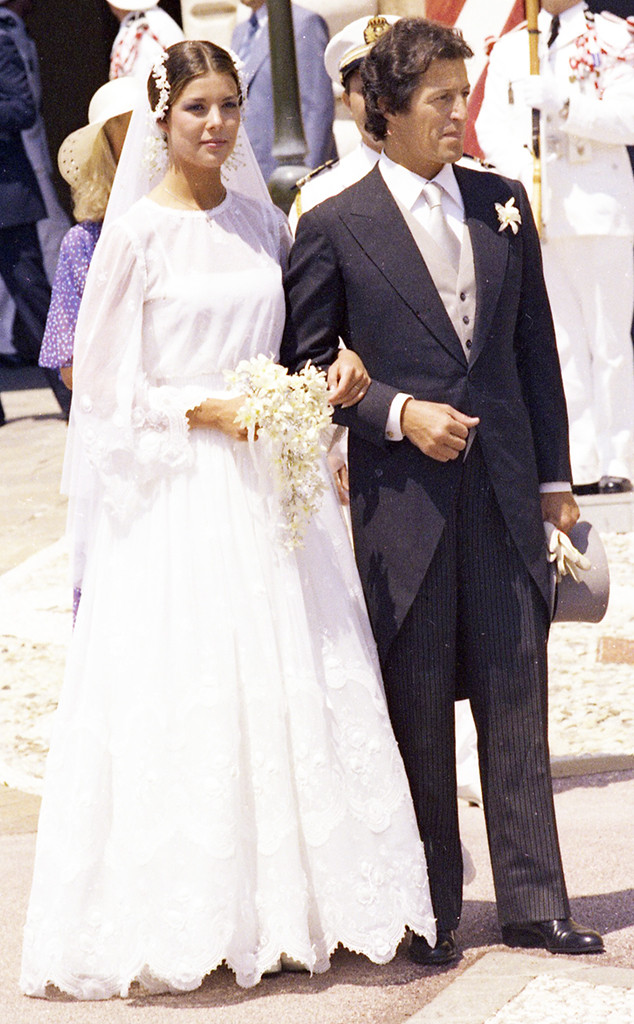
Stf/AP/Shutterstock
In June 1978, Princess Caroline married Philippe Junot in, if hardly the century, was at least considered the wedding of the year. Gilles Barthe, bishop of Frejus-Toulon—who married Caroline’s parents and baptized her 21 years beforehand—officiated the ceremony in the palace courtyard. Old family friends Cary Grant and Ava Gardner made the guest list again, as did Frank Sinatra, David Niven and Gregory Peck.
The bride wore Dior and reportedly had a little trouble getting the ring on her husband’s finger. After a walk through the streets of Monte Carlo (Grace and Rainier were driven on their wedding day), the newlyweds returned to the palace for an appearance on the balcony. As photographers below urged them to kiss, they instead blew kisses at the cameras.
“Had it been the British royal family, everyone from both sides would have stood together,” a British TV reporter said in describing the scene, concluding Grace and Rainier didn’t approve because they remained inside, per the Washington Post. A guest told the New York Times that Grace embraced the couple after their I-dos (or their “oui‘s”), but Rainier made no similar show of affection.
Also according to the Post, Tele-Monte Carlo, which had the sole broadcasting rights to the civil ceremony, had to edit out various faces made by the maid-of-honor, fidgety 13-year-old Princess Stéphanie. But they didn’t miss the teen chewing gum as she signed the marriage register.
A friend of the groom told the Times that the newlyweds would be honeymooning somewhere “far away from snoopers and everybody who hopes the marriage flops.”
“Hope” is a strong word, but the marriage did indeed flop within two years. And the parents of the bride most certainly did not approve of the match.
They had asked Caroline to wait a year when she came to them with her intention to marry Junot, a notorious playboy 17 years her senior, but she still wanted to marry him after that year had passed. They divorced in October 1980 and two months later Junot was linked in the tabloids to thrice-divorced shipping heir Christina Onassis, onetime stepdaughter of Jacqueline Kennedy Onassis. (Onassis moved on to marry Thierry Roussel.)
“Should I have put my foot down?” Rainier mused to UPI in 1981. “The blessing is that when she could stand it no longer she came straight back to her family, straight back to us. She felt she was safe, that she had a refuge and we gave her support and so she got out of a situation which could not have gotten better, only worse.” (In 1992, Caroline was granted an annulment from the Vatican, giving her permission to marry again in a Catholic ceremony.)
The prince also denied that then-16-year-old Stéphanie, who had yet to make her formal debut, was dating pop singer Michael Bosé. “They’ve never met,” he insisted.
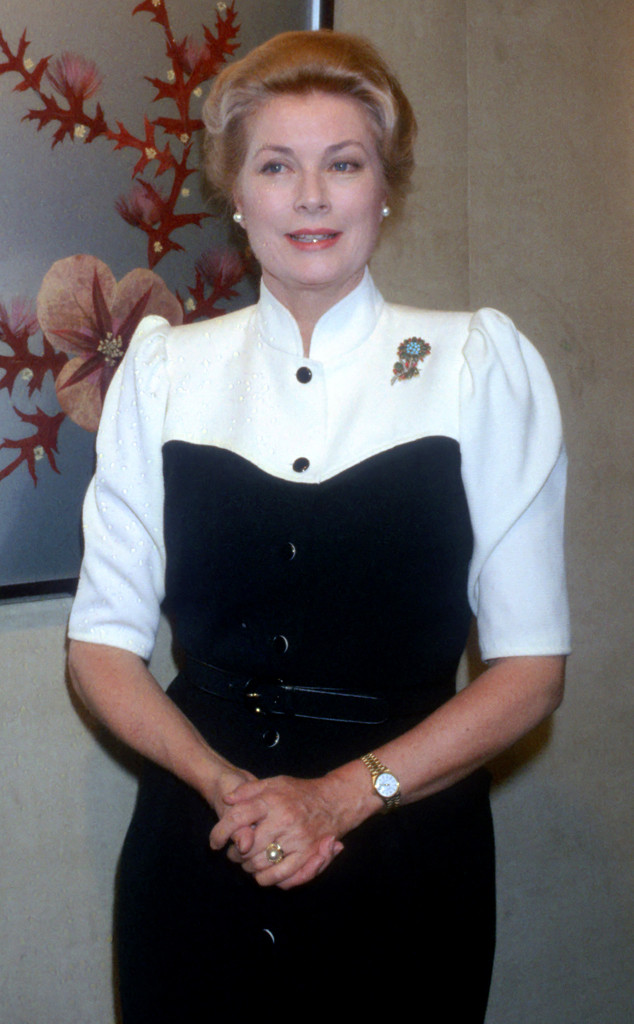
Michel Dufour/WireImage
At the time of the UPI interview, on occasion of Rainier and Grace’s 25th wedding anniversary, the couple were about to leave for Japan. Caroline, 24 and looking none the worse for wear after her bad, brief marriage, had just made an official appearance opening the International Television Festival and Market.
Prince Albert was to graduate that spring from Amherst College in Massachusetts and Rainier said the family would be together to celebrate in June, but not with a “big hullabaloo.”
Meanwhile, Grace had been spending half her time in Paris, ostensibly to be closer to Caroline in the wake of her divorce, but there were already rumors that she and the prince were leading largely separate lives, including romantically.
On Sept. 13, 1982, while leaving Roc Agel with 17-year-old daughter Stéphanie in the passenger seat to drive them to the train station on their way to Paris, where the teen was starting school in a few days, Kelly missed a harrowing turn going downhill on a steep, winding road, and they smashed right through a low retaining wall and somersaulted for 120 feet down the hill.
Neither mother nor daughter was wearing a seatbelt.
It was later determined that Kelly had suffered a cerebral hemorrhage behind the wheel of the vehicle, a 1971 Rover P6 3500, though that didn’t stop the JFK-assassination-caliber conspiracy theories from piling up as to who was driving, what really went wrong, etc. Regardless, the next day, Princess Grace of Monaco was taken off life support and died. She was only 52.
Caroline recalled to Jeffrey Robinson for his 1989 book Rainier & Grace: An Intimate Portrait that her mother “wasn’t feeling too well” before the accident. “She was incredibly tired. The summer had been very busy. She had’t stopped going places and doing things all summer long. She’d done too much. She never mentioned it or complained about it though. But she wasn’t in great form.”
Stéphanie told Robinson that her mother complained of a headache during the drive and soon felt a sharp pain in her head. It seemed as if she blacked out for a second, and the car started to swerve. Stéphanie suspected in hindsight that Grace wanted to slam on the brake but instead hit the accelerator, though it’s also possible she didn’t have feeling in her legs. Investigators found no skid marks at the crash scene.
A gardener working at a property nearby helped pull Stéphanie out of the passenger side window. “‘Please get help, call the palace, I’m Princess Stephanie, call my father and get help,'” she remembered saying.
Nearly 100 million people watched Princess Grace’s funeral, which was attended by Cary Grant, race care driver Jackie Stewart, U.S. first lady Nancy Reagan and other dignitaries from all over the world, on television.

Tim Graham/Getty Images
Princess Diana later said in the tapes used by Andrew Morton in his book Diana: Her True Story in Her Own Words, referring to Prince Charles asking her why she wanted to go to Kelly’s funeral, “I said, ‘Well, I think it’s important, because she was an outsider who married into a big family, and I’ve done the same, so it would feel right.’
“So I went to the queen and I said: ‘You know, I’d like to do this,’ and she said: ‘I don’t see why not. If you want to do this, you can’…I went there, did my bit, came back and everyone was all over me like a bad rash: ‘Oh, you did so well!’ And I thought: ‘Well, interesting.'”
“Don’t worry, it will only get worse,” Princess Grace had promised Diana in the bathroom of Goldsmiths’ Hall during the future Princess of Wales’ first event with Prince Charles after getting engaged.
Close to 2 billion tuned in for Diana’s funeral in 1997.
Prince Albert, who has been the most likely member of the family to speak on its behalf for decades, later said that his father never fully recovered from Grace’s death. But Rainier still had plenty of familial highs, including weddings and grandchildren, and lows to weather for the duration of his life.
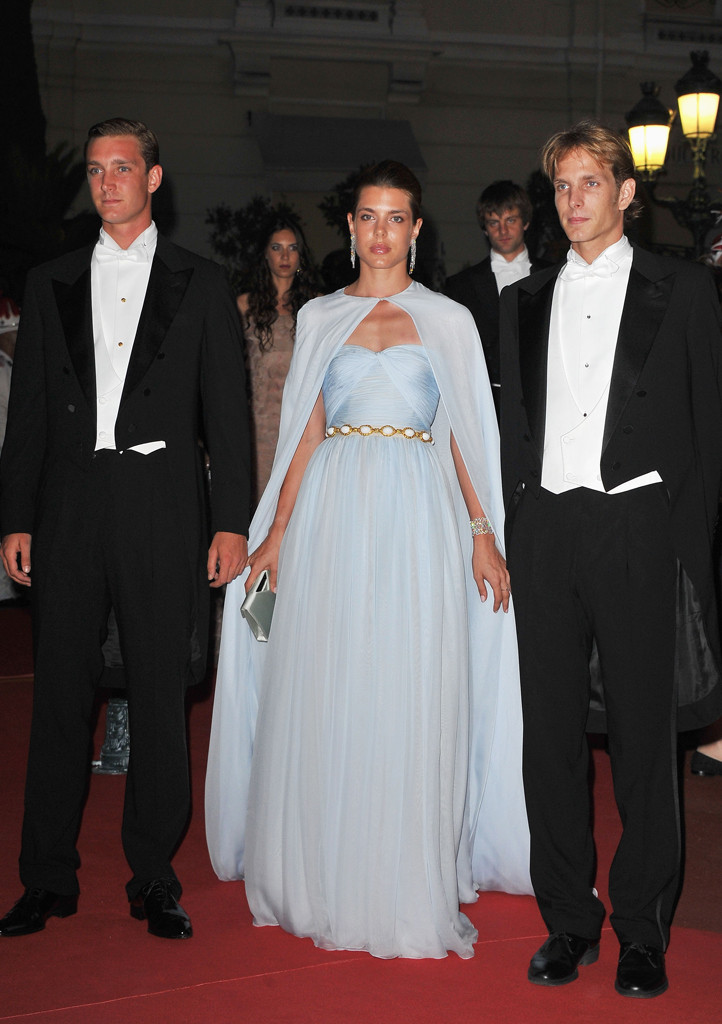
Pascal Le Segretain/Getty Images
Caroline found a true love match and married Italian real estate investor and sportsman Stefano Casiraghi in 1983, in a civil ceremony (hence it was never recognized by the Catholic church), saying her I-dos underneath a portrait of her mother.
In quick succession they had son Andrea, daughter Charlotte and another son, Pierre, and the family would split time between Monaco and the Casiraghi family homestead outside Milan.
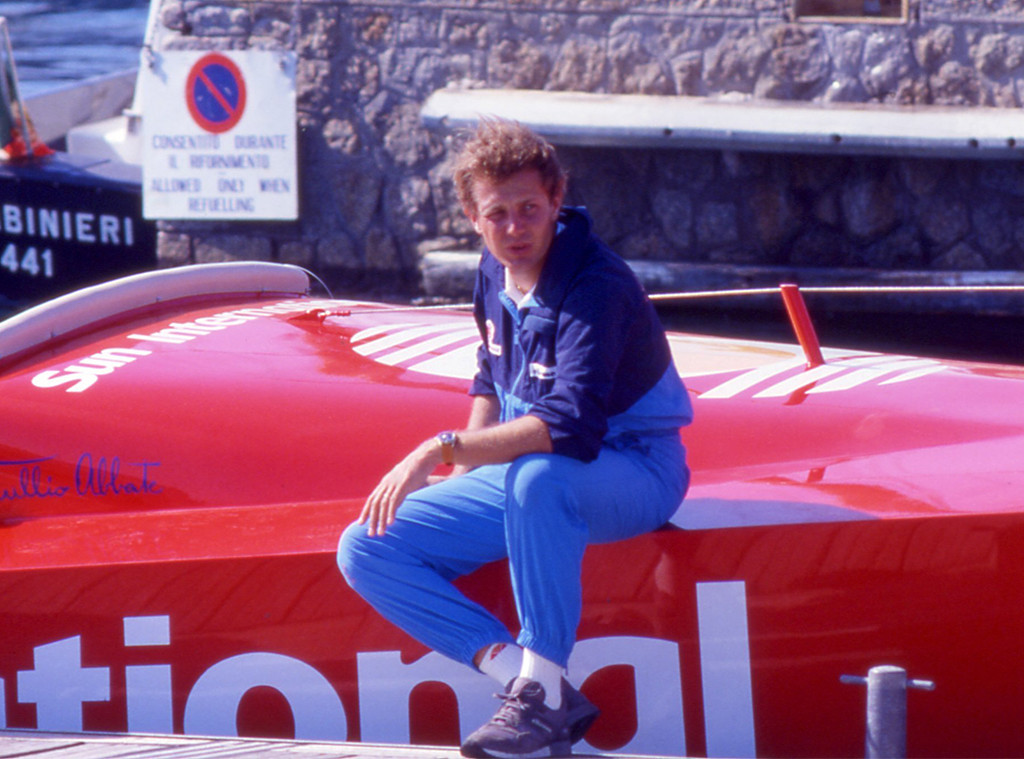
Armando Pietrangeli/REX/Shutterstock
Sadly, in 1990, while defending his world title in the World Offshore Championships, Casiraghi and his co-pilot, Patrice Innocenti, charged right into a wave in their speedboat, Pinot di Pinot, and flipped over. Innocenti was ejected, but Casiraghi was strapped into his seat and was killed when the boat slammed into the water and sank. The father of three was 30.
Caroline was already clad in widow’s black when she was seen rushing back to Monaco from Paris.
In 1999 she married Prince Ernst August of Hanover—a cousin of Queen Elizabeth II, who formally consented to the union before it took place—and they’ll mark 20 years together (and sometimes not together) on Jan. 23. Ernst has two sons, Hereditary Prince Ernst and Prince Christian, from his first marriage, and he and Caroline are parents to daughter Princess Alexandra, who will be 20 in July.
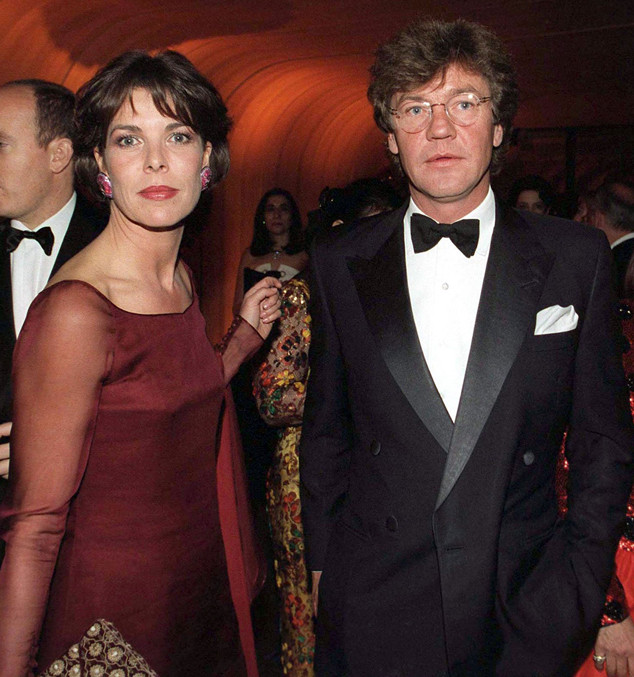
Getty Images
Theirs has not been a smooth ride, however. First of all, they met when Ernst August was still married. Then in 2000, German tabloid Bild Zeitung published a photo they claimed was of Ernst August urinating on one of the pavilions at the Expo 2000 fair, angering Turkey in the process, because it was their pavilion. He denied it was him in the picture and sued the outlet. “The Prince and the Pee,” was the BBC’s headline; they also reported that the German royal had gone to rehab after the alleged incident and Caroline was seen visiting him.
Ernst August was regularly rumored to be unfaithful, they were said to be living apart in 2009 and then, in 2010, Paris-Match photographed the German royal frolicking with an unidentified woman on a beach in Thailand.
The palace had no comment.
In a 2017 People interview, Albert called his sister a “remarkable woman,” considering everything she had been through, and a good mom and even better grandmother.
“She’s very bright and gives extremely good advice,” he said. “Every time I’ve asked her about this or that situation or about this person I’m not sure of, she’s demonstrated very good judgment. I confide in her a lot. I confide in my wife as well. But Caroline’s my sister, and I’ve known her a little bit longer.”

Courtesy: Palace of Monaco
Andrea Casiraghi married Tatiana Santo Domingo, a New York-born socialite and heiress to a Colombian conglomerate fortune, in 2013 and they have three children, son Alexandre (born before his parents married he was at first denied a spot in line to the throne but regained it after the marriage), daughter India and son Maximillian.
Charlotte graduated from the Sarbonne and has worked as a magazine writer and editor in addition to being a fixture on the international fashion scene. She had a son, Raphael, in 2013 with Moroccan-born comedian and actor Gad Elmaleh; they split in 2015. She was first linked to Dimitri Rassam, whose mother is former Bond girl actress Carol Bouquet, in March 2017 and Charlotte was seen wearing a massive diamond ring in March 2018. The couple welcomed son Balthazar in October—and, as mentioned, have avidly denied reports that they’ve called off their engagement.
Youngest brother Pierre Casiraghi, who races boats and cars, followed in his father’s footsteps into the business world. He married Beatrice Borromeo in 2015 and they have two sons, Stefano and Francesco.

Stephane Cardinale/Corbis via Getty Images
Prince Albert II, meanwhile, fathered one daughter, Jazmin Grace Grimaldi, 26, with American Tamara Rotolo, and a son, Alexandre Grimaldi-Coste, 15, with Nicole Coste, who is Togolese and was working as a flight attendant when she met the prince on a plane. But he was in no rush to settle down.
“You know—and I’ve always said this, he will be very well taken care of,” Albert said on Larry King Live in 2005, referring to his son. “He will have everything he needs and I will see him as often as possible.” He said that his support had nothing to do with the press outing him as a father of two. Even a paternity suit filed by Rotolo in 1993 didn’t force his hand, because a judge threw it out, citing jurisdiction issues because Jazmin was conceived in Monaco and Albert had no real ties to California.
“When an event like this that is strictly in the private realm and it concerns your private life when that is made public it’s sort of a shock and you do feel betrayed in many ways,” he said, referring to a French paper Coste had apparently spoken to, revealing him as her son’s biological father.
“I had already taken care and pledged support and had already started supporting. But I think the lure of recognition and being in the public eye was very appealing to her.” Albert also told Paris Match, “What matters to me is that [both kids] are certain of my affection for them.” (At the time, Jazmin was living in America her mom and Alexandre and Coste reportedly lived in a home near Monaco, provided for by the prince.)

Jason Merritt/Getty Images
The crown prince of Monaco, who assumed the throne when Prince Rainier died in 2005 and was interred next to Princess Grace, did not marry until 2011, when he was 53 and seemingly a confirmed bachelor.
Charlene Wittstock first met the prince in 2000 at the Mare Nostrum swim competition in Monte Carlo. Born in Rhodesia and 20 years Albert’s junior, the statuesque blonde was an Olympic swimmer for her adopted home of South Africa. They didn’t officially debut as an item until 2006 and weren’t engaged until 2010—an epic courtship in royal years.
Their relationship was certainly dogged by scandalous reports, including that Charlene tried to skip town right before the wedding and police at the Nice airport confiscated her passport. “Categorical lies,” she called the story, which originated in a French paper and was then picked up by Britain’s Sunday Times, which issued an apology.
Princess Charlene of Monaco did kiss her husband on the palace balcony following their religious ceremony on July 2, 2011.
In a joint interview with her husband in 2012, Charlene told CBS News, “I mean, to be honest with you, I really do not read anything that’s printed. I think ‘rumors,’ the word, says a lot about itself, I suppose.”
Asked if he noticed, when he first met Charlene, any similarities between his mother and the glamorous blonde who would become his wife, Albert replied, “Now I think you know every human being is unique. And that’s the beauty of the human race. I knew that whoever I choose to marry, that she would be compared to my mother. And I was ready for that. But I think Charlene has her own very wonderful personal qualities to be able to shine.”
The couple welcomed twins, Princess Gabriella and Prince Jacques, in 2014.

Pascal Le Segretain/Getty Images
Right up until she gave birth, however, much was written about Charlene’s alleged unhappiness in Monaco, including the ongoing disappointment that she had yet to produce a male heir to the throne.
Charlene, who had not yet picked up French, had told Britain’s Tattler magazine, “Although I have met some wonderful people since I’ve been living in Monaco, I regard them all as acquaintances. I only have two people I consider friends here.”
“She does not expect to be suddenly warmly welcomed into Monaco society, but she does think that after giving birth—especially if it’s a son—she will be more free to go off and do her own thing,” an in-the-know society person in Europe told the Daily Beast in 2014. “She has made little secret of the fact she would rather be back in South Africa, or London, or Paris, or anywhere but Monaco.”
But now married almost eight years, the reigning Prince and Princess of Monaco are holding fast.
In a 2017 interview while in South Africa to work with one of her charitable foundations, Charlene admitted that she “avoided princess parties” and never had designs on joining a royal family.
About his wife’s work-in-progress adjustment to royal life, Albert told People in 2017, “It’s more an ongoing process, getting her more familiarized with the people of Monaco, the institutional side, to give her a better understanding of how things work.
“In the past, I haven’t always had as much time as I’d like to devote to that because I’ve been traveling and she has work with her foundation, and I didn’t want to throw too much at her at once.”
Jazmin, who grew up in California and attended Fordham University in New York, didn’t have much of a relationship with her father until she was 11 and went to visit him in Monaco for the first time. But he remained in her life and the actress, singer and actress conducted an interview with Harper’s Bazaar in 2015 from the palace when she was in town for her half-brother and -sister’s baptisms.
“I was 14, getting ready to go to high school, when it hit the media that my father had a daughter, and it was me,” she recalled. “It’s a difficult time for any young adult, and it was an adjustment to have that attention. But I knew it was going to come someday.”
When she was in Monaco, Jazmin said, “we like to share family meals, have barbecues, go to the beach, everything a normal family does. Except with heavy scheduling.”
Princess Stéphanie, meanwhile, had a unique kind of trauma to recover from following their mother’s death. Not only did she suffer through the accident as well, but she had to deal with the conspiracies, such as that she was actually driving or she and Kelly were fighting in the car, in addition to the grief. She wasn’t told that Kelly had died until two days later and, still hospitalized with injuries, was unable to attend her funeral.
”I remember every minute of it,” she told Jeffrey Robinson in 1989. “It’s only in the last few years that I’ve been starting to cope with it. I had some professional help and especially in the last eight months I’ve been learning to deal with it. I still can’t go down that road, even if someone else is driving. I always ask them to take the other road. But at least I can talk about it without crying. Although it’s hard for me to get it out in front of my dad. As far as ‘m concerned, I can live with it. But I still can’t talk to my dad about it because I know it hurts him and I don’t want to do that because I love him.”
Prince Rainier told Robinson for his book, ”They did their best to keep the story running and didn’t show much human compassion for the pain that we were suffering. It was dreadful.”
”When the press makes up a story about the Mafia wanting to kill Grace, though I can’t for a moment see why the Mafia would want to kill her, if there was some interpretation that seemed even only minutely possible, I’d say, all right. But when they keep rehashing the story that Stéphanie was driving and they know it’s not true, when they know it’s been proven that she wasn’t driving, it hurts all of us.”
Stéphanie went to university in France and has been a model, fashion designer, restaurateur and singer, as well as a philanthropist and a board member of the Princess Grace Foundation—United States. Her international dating history runs deep and includes Rob Lowe and French race car driver Paul Belmondo, son of legendary French actor Jean-Paul Belmondo.

Getty Images
She had two children, Louis and Pauline, with her bodyguard turned boyfriend Daniel Ducruet before marrying him in 1995 and divorcing him just over a year later after paparazzi snapped him romping poolside with a Belgian stripper.
The princess is also mom to Camille Gottlieb, born in 1998, and would never say who the father was—though, confirming people’s suspicions, Camille herself has referred to Jean Raymond Gottlieb, a former Paris gendarme and Monaco palace guard, as her dad.
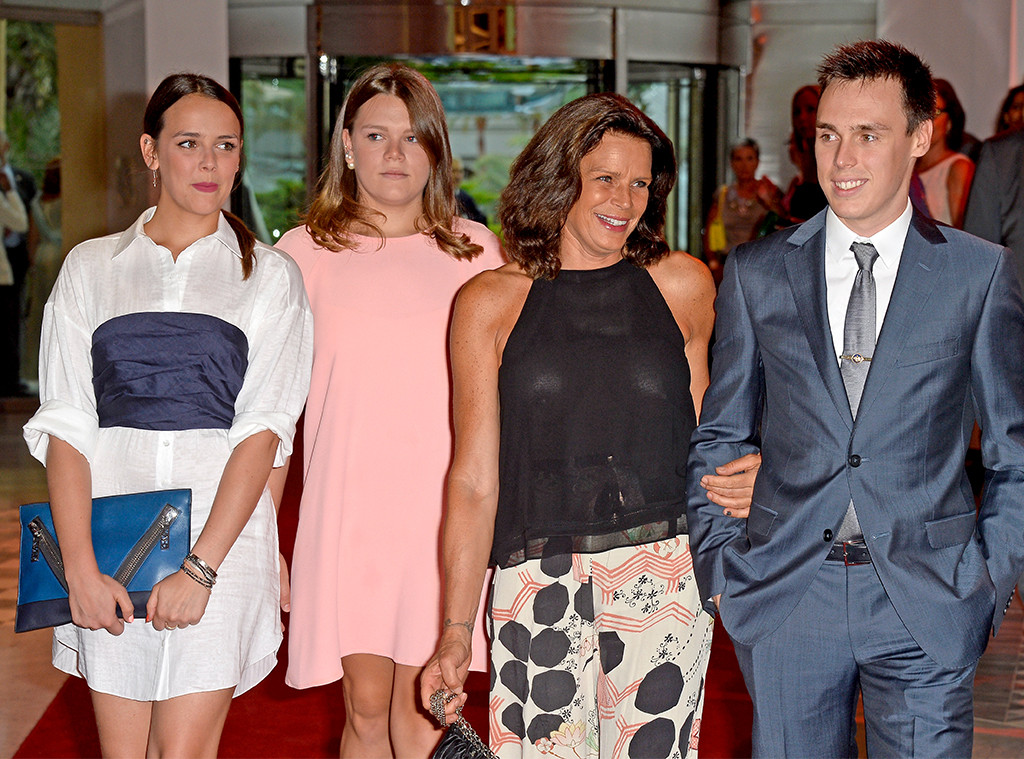
Pascal Le Segretain/Getty Images
“My father is my right lung, my mother is my left lung. Without them, I could not live,” Camille told Point de Vue last February, per Hola US. They did not stay together very long, but they always said to me, ‘We have desired you, and our happiness is that you are here.'” She added, “I am very lucky. I would not trade my family for another for nothing in the world.”
And she adored her brother and sister. “Between us, we call ourselves the ‘Three Musketeers,'” said the now 20-year-old activist, who founded an organization called Be Safe Monaco to warn against the perils of drunk driving. “With Pauline, we do not need to phone or send messages to know that everything is fine. Louis is very protective of us three, he is the most serious, the wisest. My sister is more rock, more rebellious perhaps.”
In 2001, Stéphanie packed up her kids and joined a circus caravan while dating Franco Knie, a married elephant trainer, but that didn’t last long.
The family returned to Monaco and the princess married Portuguese acrobat Adans Lopez Peres in 2003. That marriage also lasted barely a year.
Despite, or perhaps because of, the peripatetic upbringing, Camille couldn’t sing her mom’s praises enough last year. And after a picture of herself she posted alongside one of her famous late grandmother drew countless comments noting the resemblance, she said she was obviously flattered by the comparison.
“Every time my mother tells me about her, it’s to say what an extraordinary woman and what an exemplary mother she was. My mother was still very young when she died, with Louis and Pauline we are only grateful for all that she has given us. My mother is a great mom, she is my example, my model. I cannot even tell you how proud I am of her.”
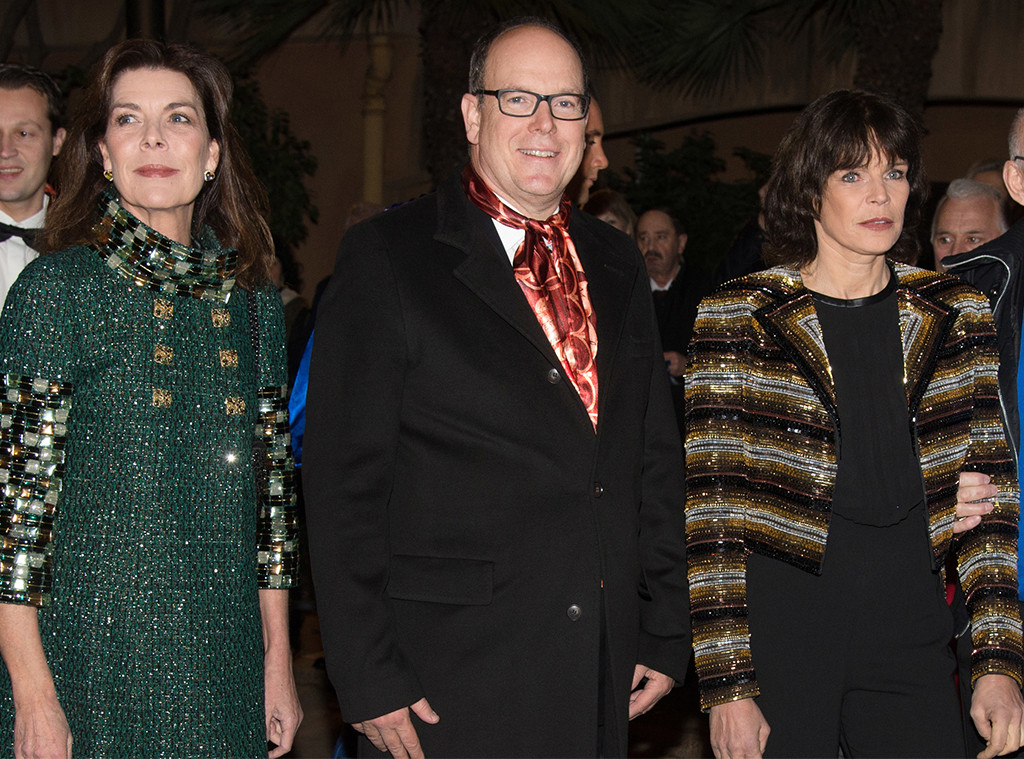
Stephane Cardinale/Corbis via Getty Images
“Coming to terms with her being in the accident was very instrumental in, well, in [Stéphanie’s] difficult years after that,” Prince Albert told the New York Times in 2007. “We all underestimated it. A lot of people did. A lot of people outside the family underestimated the trauma that she went through.”
At the time, he and his sisters were curating an exhibit of some of their mother’s possessions, including a number of her iconic gowns, for a retrospective at the Grimaldi Forum in Monaco.
“It was very much a family process,” Albert said, noting that he hadn’t seen many of the items since he was a child. “It wasn’t a painful process. It was an emotional one, but a joyful one.”
